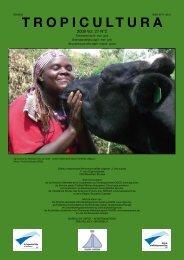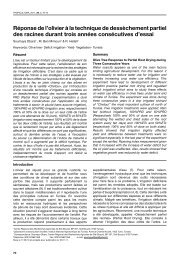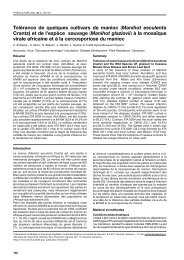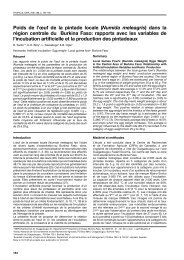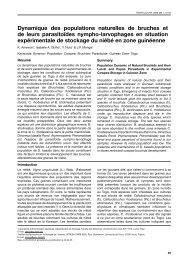Fascicule entier - Tropicultura
Fascicule entier - Tropicultura
Fascicule entier - Tropicultura
Create successful ePaper yourself
Turn your PDF publications into a flip-book with our unique Google optimized e-Paper software.
Discussion<br />
There was a great variation in bean varieties regarding<br />
the degree of susceptibility to bruchids attacks. High<br />
attacks of bean varieties by bruchids depended on<br />
approaches and type of doses applied. Local varieties<br />
were more resistant than improved, elite, commercial<br />
and marketable ones. Also, the degree of humidity<br />
of bean varieties before storage could have been of<br />
high importance in term of susceptibility to bruchids<br />
attacks. Therefore the local varieties Ishikazi and<br />
Namakala were less attacked by bruchids. However,<br />
Kirundo, although being a recent introduced variety<br />
had similar trend to Ishikazi in terms of degree of<br />
susceptibility to bruchid attacks. Such behavior was<br />
less understood. However, the variety belongs to<br />
a group of varieties currently being released under<br />
the “bean biofortification project “of the national<br />
legume crops program based at Mulungu agricultural<br />
research station in the Kivu provinces. These varieties<br />
are said to be rich in proteins, iron, zinc, etc. There<br />
is a vaste campaign to release these varieties<br />
especially in areas severely affected with children and<br />
adult malnutrition in the Kivu provinces (M. Nkonko,<br />
personal communication). Among the targeted areas,<br />
include Kabare North, Kalehe South territories of<br />
South Kivu provinces. In these areas, more than 5000<br />
children are admitted yearly in nutritional centers<br />
(Dr Bahizire, Director of Pediatric hospital of CRSN-<br />
Lwiro, personal communication). Therefore, scientific<br />
communities are mobilizing their efforts in a multisectorial<br />
approach to reduce of the frequency of child<br />
mortality due to chronic malnutrition. Malnutrition is<br />
becoming endemic in the region for several cultural<br />
and nutritional reasons. Therefore, farmers are being<br />
encouraged to adopt some agricultural technologies<br />
such as such as orange flesh genotypes and beans<br />
varieties rich in proteins, vitamins and minerals already<br />
available regional research centers within DRC.<br />
There was a high to moderated level of bruchids<br />
emergence across farmers’ storages.<br />
The difference in emerged bruchid populations<br />
between the two farmers’ associations may be due<br />
to the difference in numbers of non-sexed bruchids<br />
initially released in all treatments. Farmers’ stores<br />
used were not prior disinfested. It is therefore possible<br />
that other bruchids may redundant in ADEA stores.<br />
Reading from the figure 1, it is clear that the high<br />
level of seeds damaged does not necessary implies<br />
high level of weight loss. However, the proliferation<br />
of bruchids in stores implies high numbers of grains<br />
damaged. Minimizing weight losses in storages will<br />
require that effective measures are taken to reduce or<br />
control population density of bruchids.<br />
Over all, powders-treated beans were least attacked<br />
TROPICULTURA<br />
and, this was demonstrated by reduced emergent<br />
adult bruchid numbers, low damage level and low<br />
weight loss percentage. Fresh leaves were the least<br />
effective against bean bruchids even when applied<br />
at high rate. This was demonstrated by the highest<br />
number of adult bruchids that emerged.<br />
The emergence patterns of A. obtectus from bean<br />
varieties varied between the different treatments<br />
applied. Results from the current study say that dose<br />
of 0.2 kg powders/5 kg was effective in controlling<br />
bean bruchids in all storages. The performance of that<br />
dose was earlier observed during laboratory studies<br />
by Munyuli (10).<br />
Farmers’ method of controlling bruchids in stores<br />
reduced fairly the proliferation of insects in stores,<br />
only at the dose of 1.5 kg of fresh plant leaves/ 5 kg<br />
of bean seeds. This means that farmers are obliged<br />
to collect a huge quantity of plant leaves for the<br />
conservation of around 100 kg of bean seeds. Such<br />
activities require also more labor, sacks and space in<br />
the store. That dose seems to be not sustainable for<br />
small-scale farmers’ level since it involves depleting<br />
natural resources (botanicals) in the villages in a single<br />
cropping season.<br />
The performance of plant powders in reducing bruchid<br />
damages was rated first to fresh plant leaves by farmers<br />
during the participatory evaluation of the trails. The<br />
efficacies of all other doses tested were better than<br />
the control and had reduced adult emergent numbers<br />
and seed damage but not at a significant level.<br />
The performance of plant materials in controlling<br />
cowpea and bean bruchids, has been reported in<br />
Eastern, Central and Southern Africa, by several<br />
authors (1, 18). Similar findings to ours were reported<br />
by Silim Nahdy in Uganda while controlling cowpea<br />
bruchids (Callobruchus maculatus) with plant materials<br />
of several botanicals (Tephrosia vogelii, Capsicum<br />
fruitensis, Chenopodium sp., Piper guinensis,<br />
Eichhoria crassipes…). Powders made from various<br />
botanicals are reported to be effective in other parts<br />
of Sub-Sahara Africa (5, 16, 20).<br />
Earlier work by Agona et al., (2) showed that when<br />
used as an admixture, tobacco powder extended<br />
the storage duration of stored beans to more than<br />
4 months with insignificant bruchid damage. Ofuya<br />
(15) used tobacco powder as admixture against<br />
Callobruchus maculatus and reduced egg laying and<br />
hatchability by the pest on cowpeas.<br />
Powders made by mixing several botanicals (around<br />
twelve) do extending the storage duration of stored<br />
bean for more than 6 months with insignificant<br />
bruchid damage, while single plant powder can offer<br />
181



